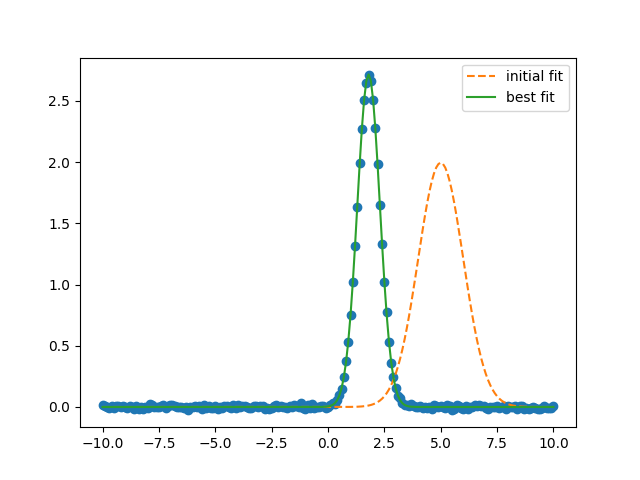Note
Go to the end to download the full example code.
Using an ExpressionModel¶
ExpressionModels allow a model to be built from a user-supplied expression. See: https://lmfit.github.io/lmfit-py/builtin_models.html#user-defined-models
import matplotlib.pyplot as plt
import numpy as np
from lmfit.models import ExpressionModel
Generate synthetic data for the user-supplied model:
x = np.linspace(-10, 10, 201)
amp, cen, wid = 3.4, 1.8, 0.5
y = amp * np.exp(-(x-cen)**2 / (2*wid**2)) / (np.sqrt(2*np.pi)*wid)
np.random.seed(2021)
y = y + np.random.normal(size=x.size, scale=0.01)
Define the ExpressionModel and perform the fit:
this results in the following output:
print(result.fit_report())
[[Model]]
<lmfit.ExpressionModel('amp * exp(-(x-cen)**2 /(2*wid**2))/(sqrt(2*pi)*wid)')>
[[Fit Statistics]]
# fitting method = leastsq
# function evals = 52
# data points = 201
# variables = 3
chi-square = 0.01951689
reduced chi-square = 9.8570e-05
Akaike info crit = -1851.19580
Bayesian info crit = -1841.28588
R-squared = 0.99967271
[[Variables]]
amp: 3.40625133 +/- 0.00512077 (0.15%) (init = 5)
cen: 1.80121155 +/- 8.6847e-04 (0.05%) (init = 5)
wid: 0.50029616 +/- 8.6848e-04 (0.17%) (init = 1)
[[Correlations]] (unreported correlations are < 0.100)
C(amp, wid) = +0.5774
plt.plot(x, y, 'o')
plt.plot(x, result.init_fit, '--', label='initial fit')
plt.plot(x, result.best_fit, '-', label='best fit')
plt.legend()

Total running time of the script: (0 minutes 0.304 seconds)
